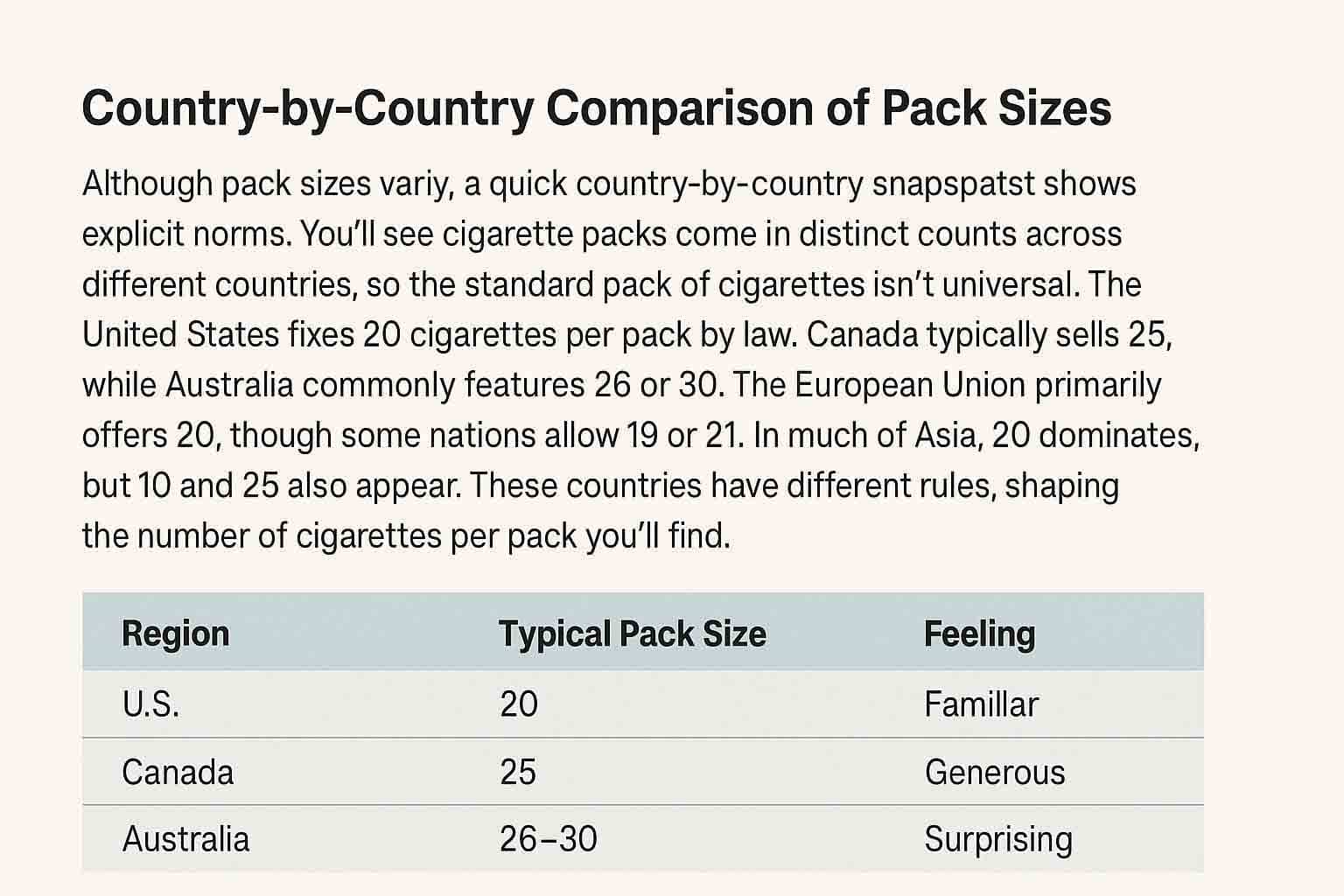How Many Cigarettes Are in a Pack? A Comprehensive Guide
2025-09-13 13:50:42
How Many Cigarettes Are in a Pack? A Comprehensive Guide
Most packs you’ll buy have 20 cigarettes, especially in the U.S. and much of Europe. But counts vary: Canada often sells 25s, Australia commonly has 26 or 30, and some places offer 10s or 19s. Soft, hard, and flip-top packs typically hold 20 units, while specialty or slide-and-shell packs may have a different capacity. Laws, taxes, costs, and consumer preferences all shape pack sizes—and some countries limit small packs to curb youth smoking. Want specifics by country, pack type, and regulations?
Main Points
- The standard pack contains 20 cigarettes in the U.S., EU, and many Asian countries.
- Variations exist: EU packs may have 19 or 21; Australia often sells packs of 26 or 30; Canada commonly sells packs of 25.
- Some markets also offer 10- or 25-count packs; mini packs can target casual users.
- Laws and regulations often set minimums/maximums, with many countries standardizing to 20 to curb consumption.
- Pack types (soft, hard, flip-top, and slide-and-shell) usually hold 20, although specialty or promotional packs may differ.
Global Standard Pack Counts and Variations
While pack sizes vary worldwide, you’ll most often see 20 cigarettes in a standard pack—especially in the United States and much of the European Union. You’ll recognize this as the standard cigarette pack because regulations in the U.S. set the number of cigarettes at 20.
In the European Union, the global standard pack is typically 20 as well, though variations like 19 or 21 appear due to local preferences.
Australia takes a different approach, with cigarette packs commonly holding 26 or 30 cigarettes. Elsewhere, you might encounter pack sizes of 10, 20, or 25, reflecting the diverse sizes available.
Some countries restrict smaller packs to deter youth smoking, banning fewer than 20. You’ll also see specialty mini packs of 10 and multipacks bundling standard units.
For compliant retail packs, choose custom cigarette packaging boxes (wholesale).
Country-by-Country Comparison of Pack Sizes

Although pack sizes vary, a quick country-by-country snapshot shows explicit norms. You’ll see cigarette packs come in distinct counts across different countries, so the standard pack of cigarettes isn’t universal. The United States fixes 20 cigarettes per pack by law. Canada typically sells 25, while Australia commonly features 26 or 30. The European Union primarily offers 20, though some nations allow 19 or 21. In much of Asia, 20 dominates, but 10 and 25 also appear. These countries have different rules, shaping the number of cigarettes per pack you’ll find.
| Region | Typical Pack Size | Feeling |
|---|---|---|
| U.S. | 20 | Familiar |
| Canada | 25 | Generous |
| Australia | 26–30 | Surprising |
Factors That Influence How Many Cigarettes Go in a Pack
Because pack size isn’t arbitrary, a few forces consistently shape how many cigarettes end up in a box. You’ll see pack sizes reflect market demand first: standard packs of 20 dominate because they strike a balance between price, convenience, and routine purchasing.
Pack sizes aren’t arbitrary—market demand makes 20-stick packs the dominant, convenient, routine-friendly choice.
Government regulations also steer cigarette counts by setting minimums or maximums to curb consumption. Economic considerations also matter—manufacturers must juggle production costs, taxes, and price points to achieve profitable configurations.
Consumer preferences and smoking habits push variety. Casual users may prefer mini packs of 10, while regular smokers stick with standard packs that fit daily routines.
Branding and packaging strategies also influence counts, as companies tailor formats to stand out, target specific segments, and comply with display rules. Together, these factors explain why pack sizes differ across places and products.
For dispensary lines, match accessories in vape boxes.
Types of Packs: Soft, Hard, Flip-Top, and More
From soft packs to flip-tops, cigarette packs come in distinct formats that strike a balance between protection, accessibility, and style.
You’ll see several types of cigarette packs that influence design and size, durability, and the number of cigarettes in a pack.
Soft packs use thin paper, feel flexible, and usually hold 20. They slip into pockets easily but offer less protection.
Hard packs use sturdy cardboard, resist crushing, and are commonly available in 20-packs.
Flip-top packs feature a hinged lid that keeps sticks fresher and speeds up access; most major cigarette brands use them in 20-count cigarette pack sizes.
Slide-and-shell packaging types deliver a sleek drawer action, often for premium lines, featuring 20 or more compartments.
Specialty packs vary: decorative or promotional runs may cut counts to 5 or 10, catering to specific preferences.
Pre-roll SKUs pair with custom pre-roll packaging boxes.
Cartons and Multipacks: How Many Packs Come Together
Think in bundles: cartons and multipacks group individual packs for convenience and value.
A standard cigarette carton usually holds 10 packs. If each pack contains 20 sticks, you’re looking at 200 cigarettes. Some premium brands trim that to a 5-pack carton, totaling 100. In places like Australia, a carton can bundle packs of 25, reaching 250 per carton.
Multipacks work differently: retailers or wholesale outlets combine standard packs into shrink-wrapped sets, appealing to bulk buyers. You might see 2-, 4-, or 6-pack multipacks, depending on consumer preferences and pricing tactics.
Because market regulations and brand strategies vary, the exact number of packs in a cigarette carton or multipack isn’t universal. Always check the label to confirm what each pack contains and the number of packs included.
Regulations and How They Shape Pack Sizes

Even if brands want flexibility, regulations essentially dictate how many cigarettes are in a pack and how that pack is designed. You’ll see governments set minimum and maximum counts for cigarette packs to support public health goals.
Many countries require standard pack sizes—often 20 units—to curb impulse purchases and simplify enforcement. Some places ban packs under 20, pushing uniformity and discouraging trial use.
Many countries standardize packs—often 20—curbing impulse buys and simplifying enforcement while discouraging trial use.
Regulations also tie pack sizes to taxation policies, making larger packs pricier and aiming to lower smoking rates by reducing affordability.
When rules change, manufacturers face compliance costs to retool lines and update labels. In Australia, plain packaging and bigger warnings limited branding options and influenced pack dimensions, reinforcing health messaging.
Packaging Design, Dimensions, and Brand Strategy
Law sets the boundaries, but within them, pack design shapes how a brand feels in your hand and looks on the shelf.
You’ll notice cigarette packaging often follows standard sizes—typically 20 sticks—because that format maximizes shelf impact and simplifies marketing strategies.
Hard packs dominate for their durability, clean edges, and ample space for health warnings and brand marks. Pack dimensions matter: height, width, and depth significantly impact grip, pocket fit, and perceived quality, thereby reinforcing branding strategies while complying with regulatory requirements.
Innovative packaging, such as flip-top and slide box formats, enhances convenience and freshness, aligning with consumer preferences for quick access.
Subtle shifts in pack dimensions and opening mechanics can signal premium positioning or value.
Your takeaway: effective design balances compliance, visibility, and differentiation—turning a regulated box into a brand asset.
Additionally, premium brands often leverage embossed logos and spot UV finishes to enhance perceived quality while maintaining regulatory compliance.
Need branded cigarette cartons? Start with custom cigarette packaging boxes.
Emerging Trends: Sustainability and Customization in Packs

While regulations still set strict limits, pack innovation is shifting toward sustainability and personalization. You’re seeing packaging evolve as sustainability and customization move center stage. Brands are testing biodegradable materials and eco-friendly inks to reduce waste, responding to rising consumer demand for greener choices and increasing regulatory pressures worldwide.
Advances in printing technology enable manufacturers to deliver unique designs, short runs, and limited editions without incurring bloated costs. You can even choose formats or finishes that match your style, which can strengthen loyalty while staying within mandated guidelines.
At the same time, minimalist design leads the way—characterized by clean lines, fewer components, and recyclable substrates. Packs are increasingly adding user-friendly features, such as easy-open seals and sturdier, slimmer forms, for improved portability.
Expect continued experimentation that strikes a balance between responsibility, functionality, and choice. Additionally, purchasing packaging in bulk can reduce per-unit costs and ensure consistent branding, reflecting a broader industry shift toward efficient and sustainable procurement.
Frequently Asked Questions
How Many Cigarettes Are in a One Pack?
You’ll usually find 20 cigarettes in one pack. However, cigarette pack sizes vary by country and brand. In Canada, 25s are common, while in some markets, 10s are sold as mini packs, and others sell packs of 26 or 30.
Smoking regulations and packaging laws shape pack design, nicotine levels labeling, and consumer habits.
Historical cigarette packaging shows evolving standards, often toward larger health warnings.
If you’re concerned about health effects, consider quitting strategies and seek support to reduce dependence.
Is 2 Cigarettes a Day a Heavy Smoker?
No, 2 cigarettes a day doesn’t make you a heavy smoker, but it still carries health risks.
Your smoking habits can reinforce addiction factors and nicotine effects, affect mental health, and shape social perceptions.
Even light use has financial costs and an environmental impact.
Consider quitting strategies like NRT, counseling, and apps.
Stay informed about regulatory changes that may impact access and pricing.
Cutting down helps, but quitting entirely offers the best protection.
Was There Ever 25 Cigarettes in a Pack?
Yes. You’ve seen 25 Cigarette Packs in several markets as part of Historical Packaging and Global Variations.
Brands experimented with them due to Smoking Regulations, Market Trends, and Consumer Preferences, alongside Pricing Strategies that positioned larger counts as value.
Brand Differences and cultural practices shaped availability, with Australia and Canada being notable examples.
Over time, Health Concerns and tighter rules reduced these sizes, although some regions also experimented with 26 or 30, reflecting evolving demand and policy shifts.
Are All Cigarette Packs 20?
No, not all packs are 20. You’ll notice that cigarette pack sizes vary due to differences in smoking regulations, brand variations, and historical packaging trends. Some regions sell 10s, 19s, 21s, 25s, even 26–30s.
Consider nicotine content, cost analysis, and environmental impact: larger packs can increase use and waste. Given health risks, explore quitting methods and tobacco alternatives.
Prices, taxes, and availability differ widely, so check local rules—and plan a quit date if you’re ready.
Conclusion
You now know how many cigarettes are in a pack, why it varies, and how rules, culture, and branding shape those counts. When you compare countries, you’ll spot 20 as a common standard, but you’ll also see 10s, 25s, and 30s. You can navigate soft vs. hard packs, cartons, multipacks, and new eco-minded designs. If you’re buying, budgeting, or just curious, you’ve got the context to read labels smartly and anticipate where packaging goes next.
Explore our range of Custom Cigarette Boxes and get the quote:
(Recommended Products)
